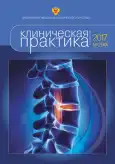ОСОБЕННОСТИ СЕНСОМОТОРНЫХ НАРУШЕНИЙ У ПАЦИЕНТОВ В РАЗНЫХ ПЕРИОДАХ ПОСЛЕ ИШЕМИЧЕСКОГО ИНСУЛЬТА
- Авторы: Екушева Е.В.1, Кипарисова Е.С.1, Ширшова Е.В.1
-
Учреждения:
- ФГБОУ ДПО ИПК ФМБА России
- Выпуск: Том 8, № 2 (2017)
- Страницы: 42-48
- Раздел: Статьи
- URL: https://journals.rcsi.science/clinpractice/article/view/8075
- DOI: https://doi.org/10.17816/clinpract8242-48
- ID: 8075
Цитировать
Полный текст
Аннотация
Полный текст
Открыть статью на сайте журналаОб авторах
Евгения Викторовна Екушева
ФГБОУ ДПО ИПК ФМБА России
Email: ekushevaev@mail.ru
к.м.н., доцент кафедры нервных болезней и нейростоматологии ФГБОУ ДПО ИПК ФМБА России
Елена Сергеевна Кипарисова
ФГБОУ ДПО ИПК ФМБА России
Елена Вениаминовна Ширшова
ФГБОУ ДПО ИПК ФМБА России
Список литературы
- Дамулин И.В., Кононенко Е.В. Постинсультные расстройства: патогенетические и клинические аспекты. Актуальные вопросы болезней сердца и сосудов 2007; 3: 4-9.
- Кадыков А.С., Черникова Л.А., Шахпаронова Н.В. Организация медико-социальной реабилитации больных. В кн.: Реабилитация неврологических больных. М., 2014; с.12-16.
- Dajpratham P. Walking function at 1-year after stroke rehabilitation: a multicenter study. J Med Assoc Thai 2014; 97(1): 107-112.
- Hara Y. Brain plasticity and rehabilitation in stro ke patients. J Nippon Med Sch 2015; 82(1): 4-13.
- Pundik S., McCabe J.P, Hrovat K. et al. Recovery of post stroke proximal arm function, driven by complex neuroplastic bilateral brain activation patterns and predicted by baseline motor dysfunction severity. Frontiers in Neurology 2015; 9: 1-13.
- Wu C.Y., Huang P.C., Chen Y.T. et al. Effects of mirror therapy on motor and sensory recovery in chronic stroke: a randomized controlled trial. Arch Phys Med Rehabil 2013; 94: 1023-1030.
- McCabe J., Monkiewicz M., Holcomb J. et al. Comparison of robotics, functional electrical stimulation and motor learning methods for treatment of persistent upper extremity dysfunction after stroke: a randomized controlled trial Arch Phys Med Rehabil 2015; 96: 981-990.
- Екушева Е.В., Дамулин И.В. Реабилитация после инсульта: значение процессов нейропластичности и сенсомоторной интеграции. Журнал неврологии и психиатрии имени С.С. Корсакова 2013; 12(2): 35-41.
- Oldfield R.C. The assessment and analysis of handedness: the Edinburgh inventory Neuropsychologia 1971; 9(1): 97-113.
- Гнездицкий В.В. Вызванные потенциалы мозга в клинической практике. М., 2003.
- Lo A.C., Guarino P.D., Richards L.G. et al. Robot-assisted therapy for long-term upper-limb impairment after stroke. N Engl J Med 2010; 362:1772-1783.
Дополнительные файлы






